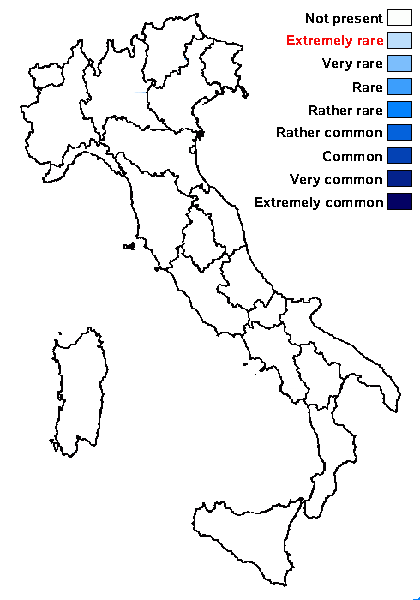Metamelanea umbonata Henssen
Lichenologist, 21: 105, 1989
Synonyms:
Distribution:
Description: Thallus crustose, homoiomerous, gelatinous when wet, episubstratic, brown-black to very dark greenish black or dark olive brown, somewhat glossy, areolate, forming up to 5 cm wide patches, the areoles 0.2-0.6 mm wide, c. 0.3 mm thick, more or less angular, obtusely wedge-shaped in section, the surface with numerous, densely aggregated, erect, 12-35 µm wide, lobule-like outgrowths containing the densely packed photobiont cells surrounded by a loose network of hyphae. Apothecia adnate, 1-7 per areole, up to 0.6 mm across, with a blackish, umbonate to gyrose disc, the umbo up to 120 µm broad and 70 µm high, a dark reddish brown proper margin, and a well-developed, entire, coronate, persistent thalline margin, proper and thalline margin often separated by a thin fissure. Thalline exciple up to 200 µm wide; proper exciple up to 20 µm wide apically, up to 10 µm wide basally, dark brown in upper part, paler in lower part; epithecium brown; hymenium colourless to brownish in upper part, 90-150 um high, K/I+ blue; paraphyses septate, sparingly branched and anastomosing, the apical cells slightly swollen; hypothecium colourless to pale brown, K/I+ blue. Asci 8-spored, long-cylindrical-clavate, thin-walled, without internal amyloid structures. Ascospores 1-celled, hyaline, broadly ellipsoid, 11-13.5 x 8-9.5 µm, thin walled. Pycnidia laminal, immersed, 110-140 µm high, 40-65 µm across, with a colourless wall. Conidia bacilliform, 2-3.5 x 1-1.5 µm. Photobiont cyanobacterial, chroococcoid, the cells surrounded by brownish gelatinous sheaths, densely aggregated in vertical columns. Spot tests: all negative. Chemistry: without lichen substances.Note: a rare species, described from Switzerland and also known from Scandinavia, growing in seepage tracks on steeply inclined, damp faces of calciferous rocks. To be looked for in the Italian Alps.
Growth form: Crustose
Substrata: rocks
Photobiont: cyanobacteria, coccaceous (e.g. Gloeocapsa)
Reproductive strategy: mainly sexual
On otherwise dry surfaces with short periods of water seepage after rain

Predictive model
Growth form: Crustose
Substrata: rocks
Photobiont: cyanobacteria, coccaceous (e.g. Gloeocapsa)
Reproductive strategy: mainly sexual
On otherwise dry surfaces with short periods of water seepage after rain

Predictive model


